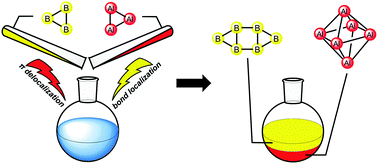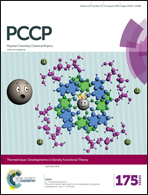Planar vs. three-dimensional X62−, X2Y42−, and X3Y32− (X, Y = B, Al, Ga) metal clusters: an analysis of their relative energies through the turn-upside-down approach†‡
Abstract
Despite the fact that B and Al belong to the same group 13 elements, the B62− cluster prefers the planar D2h geometry, whereas Al62− favours the Oh structure. In this work, we analyse the origin of the relative stability of D2h and Oh forms in these clusters by means of energy decomposition analysis based on the turn-upside-down approach. Our results show that what causes the different trends observed is the orbital interaction term, which combined with the electrostatic component do (Al62− and Ga62−) or do not (B62−) compensate the higher Pauli repulsion of the Oh form. Analysing the orbital interaction term in more detail, we find that the preference of B62− for the planar D2h form has to be attributed to two particular molecular orbital interactions. Our results are in line with a dominant delocalisation force in Al clusters and the preference for more localised bonding in B metal clusters. For mixed clusters, we have found that those with more than two B atoms prefer the planar structure for the same reasons as for B62−.

- This article is part of the themed collection: Developments in Density Functional Theory

 Please wait while we load your content...
Please wait while we load your content...